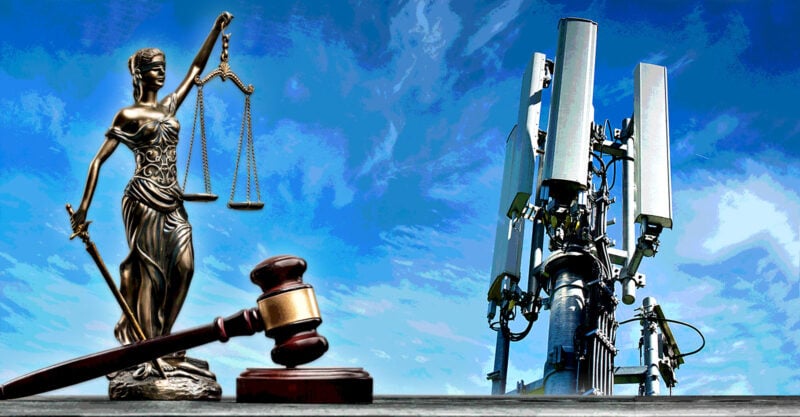Miss a day, miss a lot. Subscribe to The Defender's Top News of the Day. It's free.
A Los Angeles County Superior Court judge delivered a split decision Wednesday in a lawsuit seeking to halt the fast-tracked proliferation of wireless infrastructure without environmental review and without residents’ right to appeal.
In his ruling, Judge James C. Chalfant dismissed claims that the ordinances violate due process rights by preventing residents from contesting individual wireless project permits near their homes. He also dismissed a minor claim about a bureaucratic procedure.
However, he allowed pivotal allegations that the county is illegally sidestepping state environmental law through its new rules for approving wireless infrastructure projects.
Because the ruling bars a sweeping countywide due process challenge, the plaintiffs say it places an impossible burden on individuals to fund separate cases for each wireless facility installed near their properties without notice.
With core issues still intact, the suit — filed by Children’s Health Defense (CHD) and a coalition of community and environmental groups — proceeds to trial on March 12.
The coalition includes Fiber First LA, Mothers of East LA, Boyle Heights Community Partners, United Keetoowah Band of Cherokee Indians in Oklahoma, Union Binacional de Organizaciones de Trabajadores Mexicanos Ex Braceros 1942-1964, California Fires & Firefighters, Malibu For Safe Tech, EMF Safety Network, California for Safe Technology and 5G Free California.
On March 7, 2023, CHD and the coalition sued Los Angeles County after the county’s Board of Supervisors — despite prior public outcry — adopted amendments to title 16 and title 22 of the county code.
The lawsuit alleges the amendments violate the California Environmental Quality Act (CEQA) by exempting projects under the ordinances from CEQA review.
The lawsuit also initially claimed that the ordinances raised constitutional due process concerns with wireless projects that directly affect residents, who will suffer significant losses of personal and real property rights without the ability to contest. This is one of the claims Judge Chalfant struck from the suit.
Lawyers for Los Angeles County filed a motion for judgment on the pleadings, asking the court to disregard five of the plaintiffs’ eight claims.
W. Scott McCollough, attorney for the plaintiffs, told The Defender that while he was disappointed the judge allowed two of the plaintiffs’ claims to be removed, he was glad the judge did not dismiss most of the claims.
For example, the plaintiffs can still argue the county’s ordinances violate environmental impact law.
They also can argue that the county’s new way of dealing with wireless project applications — using what the county calls “ministerial review” — is little more than a meaningless “rubberstamping” process devoid of thoughtful decision-making, he said.
McCollough — chief litigator for CHD’s electromagnetic radiation (EMR) and wireless cases — also pointed out that Los Angeles County sought only to dismiss five of the plaintiffs’ eight claims because the county had “no viable legal argument” for dismissing the other three.
In other words, the county knew it didn’t have a strong argument for attempting to dismiss the case altogether, so it just tried to weaken the plaintiffs’ arguments.
“This was the fist fight right before kickoff,” McCollough said. “We got stung a little bit, but for the most part, the case goes forward. We’re hopeful of a successful outcome.”
Due process claim must be brought via individual cases
The judge’s ruling about a minor bureaucratic technicality wasn’t a big deal, according to McCollough.
The more important ruling, McCollough said, is that “We will not be allowed to claim that the ordinance doesn’t require notice and an opportunity to contest by those who would be impacted by a particular project.”
McCollough explained that the plaintiffs presented this claim as a “facial challenge” that called for the court to strike down or change an entire ordinance countywide, rather than just challenging the application of the ordinance to a specific cell site permit request.
“That’s a really high hurdle to get across,” he said, adding the judge was essentially saying, “You have not shown what is necessary to be able to go forward” with that kind of challenge.
The judge didn’t say the plaintiffs were wrong about the law requiring due process, according to McCollough, but rather that they brought this issue too soon.
“The courts can only consider it after someone does not get notice of a specific planned wireless project site and then challenges the lack of notice for that individual permit,” he said.
Ruling will have ‘disproportionate impact on low-income minority communities’
Although the judge’s ruling may make sense from a legal procedural standpoint, McCollough called it “bothersome” because it is realistically very difficult for individuals to bring their own lawsuits.
That’s why it would have been helpful to include a due process claim in the current lawsuit supported by several groups.
Brenda Martinez, a Los Angeles County resident and founding member of Fiber First LA, agreed, saying the ruling will have a “disproportionate impact on low-income minority communities.”
She told The Defender, “Folks in my community are low-income and none of us have funds to pay legal fees for a suit over an individual permit. I won’t speak to the law, but the result is simply unfair.”
Fiber First LA member Julie Levine also criticized the ruling for excluding the plaintiffs’ due process claim.
‘It is horrible to be so powerless’
Levine told The Defender that she personally experienced how someone’s entire life can be upended by wireless facilities that suddenly appear near their home, without notice or any opportunity to contest their placement.
Levine said:
“I owned a beautiful home in Topanga, but got sick after the local electric utility installed smart meters against my will in 2020. I was forced to sell my home in 2021 at great loss, and we moved into a rental home. I did not want to get blindsided again, so I was proactive and repeatedly asked for information on proposed towers near the rental.
“Even though I specifically asked, the local zoning officials refused to tell me whether any were going in nearby. Topanga uses the so-called ‘ministerial review’ similar to what Los Angeles County did so I did not get notice when three small cells were put in across the street and at closeby intersections.
“I once again started to suffer sleeplessness, lethargy, brain fog and uncontrolled shaking, so I had to pack up and move another time.”
Levine said that altogether she’s lost over $1 million because of wireless infrastructure erected on or near her residence without notice and over her repeated written objections.
“We now have a place in a rural area where there is not a lot of [wireless] radiofrequency radiation but every day I am afraid I will once again start experiencing the familiar symptoms from some nearby wireless facilities erected without my knowledge or consent,” she said
She can’t handle more financial setbacks — but the emotional toll is even worse. “It is horrible to be so powerless.”
Levine added, “People need to know what the telecoms and local authorities are doing to all of us. Our case is all about trying to ensure others are not forced to deal with what has happened to me.”
Miriam Eckenfels-Garcia, director of CHD’s EMR and Wireless Program, told The Defender, “We see this lawsuit as an important piece to push back against the uncontrolled rollout of cell towers and small cells close to people’s homes and to preserve local rights. It is time to make our voices heard.”
CHD and the local community groups are organizing a press conference and rally in front of the courthouse on the case’s trial date, March 12. “People in the area should join if they can,” Eckenfels-Garcia said.










